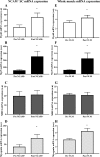Consistent expression pattern of myogenic regulatory factors in whole muscle and isolated human muscle satellite cells after eccentric contractions in humans
- PMID: 31513447
- PMCID: PMC6879834
- DOI: 10.1152/japplphysiol.01123.2018
Consistent expression pattern of myogenic regulatory factors in whole muscle and isolated human muscle satellite cells after eccentric contractions in humans
Abstract
Skeletal muscle satellite cells (SC) play an important role in muscle repair following injury. The regulation of SC activity is governed by myogenic regulatory factors (MRF), including MyoD, Myf5, myogenin, and MRF4. The mRNA expression of these MRF in humans following muscle damage has been predominately measured in whole muscle homogenates. Whether the temporal expression of MRF in a whole muscle homogenate reflects SC-specific expression of MRF remains largely unknown. Sixteen young men (23.1 ± 1.0 yr) performed 300 unilateral eccentric contractions (180°/s) of the knee extensors. Percutaneous muscle biopsies from the vastus lateralis were taken before (Pre) and 48 h postexercise. Fluorescence-activated cell sorting analysis was utilized to purify NCAM+ muscle SC from the whole muscle homogenate. Forty-eight hours post-eccentric exercise, MyoD, Myf5, and myogenin mRNA expression were increased in the whole muscle homogenate (~1.4-, ~4.0-, ~1.7-fold, respectively, P < 0.05) and in isolated SC (~19.3-, ~17.5-, ~58.9-fold, respectively, P < 0.05). MRF4 mRNA expression was not increased 48 h postexercise in the whole muscle homogenate (P > 0.05) or in isolated SC (P > 0.05). In conclusion, our results suggest that the directional changes in mRNA expression of the MRF in a whole muscle homogenate in response to acute eccentric exercise reflects that observed in isolated muscle SC.NEW & NOTEWORTHY The myogenic program is controlled via transcription factors referred to as myogenic regulatory factors (MRF). Previous studies have derived MRF expression from whole muscle homogenates, but little work has examined whether the mRNA expression of these transcripts reflects the pattern of expression in the actual population of satellite cells (SC). We report that MRF expression from an enriched SC population reflects the directional pattern of expression from skeletal muscle biopsy samples following eccentric contractions.
Keywords: fluorescence-activated cell sorting; mRNA expression; myogenic regulator factors; satellite cell.
Conflict of interest statement
No conflicts of interest, financial or otherwise, are declared by the authors.
Figures



Similar articles
-
Co-expression of IGF-1 family members with myogenic regulatory factors following acute damaging muscle-lengthening contractions in humans.J Physiol. 2008 Nov 15;586(22):5549-60. doi: 10.1113/jphysiol.2008.160176. Epub 2008 Sep 25. J Physiol. 2008. PMID: 18818249 Free PMC article.
-
Function of the myogenic regulatory factors Myf5, MyoD, Myogenin and MRF4 in skeletal muscle, satellite cells and regenerative myogenesis.Semin Cell Dev Biol. 2017 Dec;72:19-32. doi: 10.1016/j.semcdb.2017.11.011. Epub 2017 Nov 15. Semin Cell Dev Biol. 2017. PMID: 29127046 Review.
-
Impact of repeated bouts of eccentric exercise on myogenic gene expression.Eur J Appl Physiol. 2007 Nov;101(4):427-36. doi: 10.1007/s00421-007-0510-z. Epub 2007 Jul 20. Eur J Appl Physiol. 2007. PMID: 17641910
-
Effect of eccentric and concentric contraction mode on myogenic regulatory factors expression in human vastus lateralis muscle.J Muscle Res Cell Motil. 2022 Mar;43(1):9-20. doi: 10.1007/s10974-021-09613-x. Epub 2022 Jan 12. J Muscle Res Cell Motil. 2022. PMID: 35018575 Clinical Trial.
-
Skeletal muscle hypertrophy and regeneration: interplay between the myogenic regulatory factors (MRFs) and insulin-like growth factors (IGFs) pathways.Cell Mol Life Sci. 2013 Nov;70(21):4117-30. doi: 10.1007/s00018-013-1330-4. Epub 2013 Apr 4. Cell Mol Life Sci. 2013. PMID: 23552962 Free PMC article. Review.
Cited by
-
Metabolic Health-The Role of Adipo-Myokines.Int J Mol Sci. 2019 Dec 6;20(24):6159. doi: 10.3390/ijms20246159. Int J Mol Sci. 2019. PMID: 31817641 Free PMC article. Review.
-
Aerobic conditioning alters the satellite cell and ribosome response to acute eccentric contractions in young men and women.Am J Physiol Cell Physiol. 2022 Dec 1;323(6):C1577-C1585. doi: 10.1152/ajpcell.00418.2022. Epub 2022 Oct 24. Am J Physiol Cell Physiol. 2022. PMID: 36280394 Free PMC article.
-
Nestin and osteocrin mRNA increases in human semitendinosus myotendinous junction 7 days after a single bout of eccentric exercise.Histochem Cell Biol. 2022 Jul;158(1):49-64. doi: 10.1007/s00418-022-02101-4. Epub 2022 Apr 15. Histochem Cell Biol. 2022. PMID: 35428952 Clinical Trial.
-
Analysis of plasma-derived small extracellular vesicle characteristics and microRNA cargo following exercise-induced skeletal muscle damage in men.Physiol Rep. 2024 Sep;12(18):e70056. doi: 10.14814/phy2.70056. Physiol Rep. 2024. PMID: 39304515 Free PMC article.
-
Divergent Roles of Inflammation in Skeletal Muscle Recovery From Injury.Front Physiol. 2020 Feb 13;11:87. doi: 10.3389/fphys.2020.00087. eCollection 2020. Front Physiol. 2020. PMID: 32116792 Free PMC article. Review.
References
-
- Alexander MS, Rozkalne A, Colletta A, Spinazzola JM, Johnson S, Rahimov F, Meng H, Lawlor MW, Estrella E, Kunkel LM, Gussoni E. CD82 is a marker for prospective isolation of human muscle satellite cells and is linked to muscular dystrophies. Cell Stem Cell 19: 800–807, 2016. doi:10.1016/j.stem.2016.08.006. - DOI - PMC - PubMed
Publication types
MeSH terms
Substances
LinkOut - more resources
Full Text Sources
Medical
Research Materials
Miscellaneous

